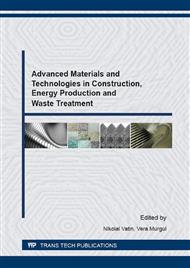p.3
p.9
p.16
p.22
p.28
p.33
p.40
p.47
Improving Producing Characteristics of Constructions through FE-NI and FE-NI-CR Alloy Coatings with a Given Structure
Abstract:
The article considers innovative materials that are recommended to be used as a coating for reinforcement of bearing structures of high-rise buildings, bridges, tunnels and underground structures, and as a coating for storagetanks of crude oil instead of high-alloy steel grades 20H23N18, 08H18N10. Nanostructural alloy coating Fe-Ni (> 80% Fe) and alloy coating Fe-Ni-Cr (> 70% Fe), containing in addition to α-Fe a new phase ε-Fe with hexagonal close-packed lattice (GPUr) were obtained by high frequency periodic current at atmospheric pressure and room temperature. Existence of phase ε-Fe was confirmed by X-ray diffraction method, electron-probe test with an electronic probe, scanning atomic force microscopy. Phase transition α-Fe → ε-Fe was observed in the deposition process. A special feature of this phase is the presence of a nanocrystal structure. The main factors in the formation of the hexagonal system are the frequency and duty cycle. The maximum number of ε-Fe phase in the Fe-Ni alloy is 30% and the alloy Fe-Ni-Cr is 20%. This phase has an essential effect on the producing characteristics of the studied coatings. Due to the corrosion resistance in the chloride ions environment Fe-Ni alloy deposited by a high frequency alternating current is 7.5 times greater than high-alloy steel 20X23H18 and 08H18N10. Additionally the nanostructure plated with Fe-Ni-Cr alloy coating made possible to increase its microhardness. Fe-Ni alloy coating can be used as coatings for storage tanks of crude oil and Fe-Ni-Cr alloy coating can be recommended to harden the supporting structures of high-rise buildings, bridges, tunnels and underground structures.
Info:
Periodical:
Pages:
16-21
Citation:
Online since:
September 2016
Authors:
Price:
Сopyright:
© 2016 Trans Tech Publications Ltd. All Rights Reserved
Share:
Citation:


